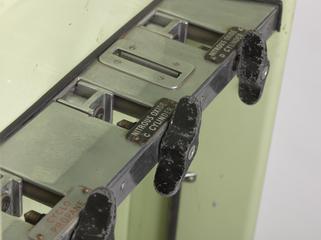Anaesthetic apparatus
Nitrous oxide, ether and oxygen anaesthetic apparatus, without oxygen bottle, by Allen and Hanburys c.1935 in strong cardboard case (complete), English, c.1935.
Made up of gas cylinders (2), iron (cast), painted black; gas valves (2), brass (chromium plated), mostly; tubes, rubber; facepieces (5), rubber; respiration ether, rubber; bottle, glass, clear; indicator; stand & gas pipes, brass (chromium plated), ether bottle; case, cardboard, brown, as imitation leather
More
Nitrous oxide or ‘laughing gas’ has been used as an anaesthetic since the mid-1800s. In this apparatus, nitrous oxide and oxygen are bubbled through the clear glass bottle separately so the right mix of air and anaesthetic can be achieved. The apparatus includes facemasks to allow patients to breathe in the gases, as well as tubing for nasal inhalation.
Intended for general surgical use in a hospital, the complete kit in its brown fibre box with carrying handle weighed 110 kg and cost 10 guineas in 1935. The apparatus was made by Allen & Hanburys Ltd and the nitrous oxide cylinders by Coxeter. The apparatus was expensive to buy and maintain and had to be used by trained staff.
- Materials:
- cast iron , brass (copper, zinc alloy) , chromium plated , rubber (unidentified) , glass and cardboard
- Object Number:
- A630961/1
- type:
- anaesthetic machine





